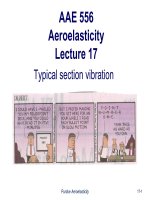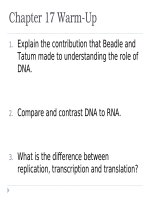Lecture 17 volcanoes
Bạn đang xem bản rút gọn của tài liệu. Xem và tải ngay bản đầy đủ của tài liệu tại đây (12.96 MB, 105 trang )
Today: Chapter 9: The Wrath of Vulcan
Volcanic Eruptions
Term Break Extra Credit due this Friday by end of lecture.
Today’s Lecture: Chapter 9
Volcanic activity
Basic types of eruptions
Anatomy of a volcano
Materials erupted
Classes of volcanoes
Basaltic volcanoes
Intermediate volcanoes
Silicic volcanoes
Volcanic hazards
Case Study: Mt. Saint Helens
Types of Volcanic Eruptions
Fig. 09.09ab
W. W. Norton
Central Eruption
Fissure Eruption
Basic Anatomy of a Volcano
Fig. 09.10
W. W. Norton
HY DROTHERMA L
DEPOSITS A S
REPOSITORIES FOR
GEOLOGIC
INFORMA TION
Most terrestrial hydrothermal
systems are sustained by
magmatic heat sources.
Variations in the temperature
(and density) of fluids drives
convective circulation in the
crust, producing large-scale
transfers of energy and
materials.
As hot fluids move through
the crust, they interact
chemically with their host
rocks, leaving behind
distinctive geochemical, and
mineralogical signatures.
Materials extruded during an eruption
Volcanoes erupt:
◆ Lava
◆ Gases
◆ Pyroclastics
Fragmented
rock, ash &
dust
Ash and tephra
Explosive eruption
Volcanic bombs
Side vent
Eroded cone
Lava cone
Sills
p.248-249a
Mud
flows
(older)
Pyroclastic flow
(nuée ardente)
Sequential
ash and lava
layers
Lava flow
Dikes
Fracturing
original artwork by Gary Hincks
Cinder cones
Lava pavement
(cracked/broken)
Old lava dome
Lavas
Sedimentary
rocks
Laccolith
Metamorphic
rocks
Chimney
Contact
metamorphism
Granite
intrusion
(older/cold)
Magma chamber
Fig. 09.24
W. W. Norton
volcanic
pipe/neck
after erosion
before erosion
Shiprock, NM
Fig. 09.04a
Stephen Marshak
Fig. 09.04b
Stephen Marshak
Volcanologists recognize 3 general volcano types:
a. Shield volcanoes
b. Composite cones
c. Cinder cones
Types of Volcanoes
9 km
150 km
Shield volcano (e.g. Hawaii)
3 km
p.248-249c
15 km
original artwork by Gary Hincks
Composite volcano (e.g. Vesuvius)
0.3 km
1.5 km
Cinder cone (e.g. Sunset crater)
What Controls the Form of a Volcano?
Basaltic flow
Andesitic flow
Rhyolitic dome
Rhyolitic spire
Factor I: Magma Viscosity
Silicon-oxygen tetrahedra tend to link
up in magmas and form chains.
In magmas with a high silica content
(e.g. granitic; ~70% by weight) many silica
chains form, especially at the lower eruption
temperature of silica-rich lavas.
This increases the viscosity of the magma.
Viscosity:
Resistance of a fluid to flow.
High viscosity lavas:
- Don’t flow far from eruption center
Factor II: Gas Content of Magma
With viscosity, gas content
Largely determines if an
eruption will be:
Explosive
or
“Gentle”
Non-explosive basaltic eruption
Contrast: Explosive
silicic eruption
The nature of volcanic eruptions
So, in a nutshell…
Amount of dissolved gas
+
Viscosity of magma (silica content
and temperature)
=
Explosiveness of eruption
The nature of volcanic eruptions
What determines if an eruption is
- Explosive?
- “Gentle”?
3 primary factors:
◆ magma’s composition
more silica
more viscous (linking of silicon-oxygen
tetrahedra)
The nature of volcanic eruptions
What determines if an eruption is
- Explosive?
- “Gentle”?
3 primary factors:
◆ Magma’s composition
more silica
more viscous (linking of silicon-oxygen
tetrahedra)
◆ Magma’s temperature
hotter magma
less viscous
The nature of volcanic eruptions
What determines if an eruption is
- Explosive?
- “Gentle”?
3 primary factors:
◆ magma’s composition
more silica
more viscous (chains)
◆ magma’s temperature
hotter magma
Viscosity
less viscous
◆ Amount of gas in magma
Can increase fluidity
Fluidity
Let’s look in more detail at:
a. Shield volcanoes
b. Cinder cones
c. Composite cones
◆ low profile
◆ broad base
◆ basaltic lavas
◆ flows are thin
◆ travel far from
source









